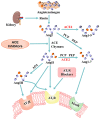Determining available strategies for prevention and therapy: Exploring COVID‑19 from the perspective of ACE2 (Review)
- PMID: 33576441
- PMCID: PMC7891831
- DOI: 10.3892/ijmm.2021.4876
Determining available strategies for prevention and therapy: Exploring COVID‑19 from the perspective of ACE2 (Review)
Abstract
Coronavirus disease 2019 (COVID‑19) is an acute infectious pneumonia caused by a novel type of coronavirus infection. There are currently no clinically available specific drugs for the treatment of this virus. The process of host invasion is the key to viral infection, and it is a mechanism that needs to be considered when exploring antiviral drugs. At present, studies have confirmed that angiotensin‑converting enzyme II (ACE2) is the main functional receptor through which severe acute respiratory syndrome coronavirus (SARS‑CoV‑2) invades host cells. Therefore, a number of studies have focused on this field. However, as ACE2 may play a dual role in mediating susceptibility and immunity to SARS‑CoV‑2 infection, the role of ACE2 in viral infection is controversial. Beginning with the physiological function of ACE2, the present review article summarizes the influence of the ACE2 content on the susceptibility to the virus and acute lung injury. Drug mechanisms were taken as the starting point, combined with the results of clinical trials, specifically elaborating upon and analyzing the efficacy of several ACE2‑centered therapeutic drugs and their potential effects. In addition, the current status of ACE2 as a targeted therapy for COVID‑19 is discussed in order to provide new insight into the clinical prevention and treatment of COVID‑19.
Keywords: SARS‑CoV‑2; COVID‑19; spike protein; ACE2; RAS; therapeutics; mechanism.
Conflict of interest statement
The authors declare that they have no competing interests.
Figures




Similar articles
-
Host cell entry mediators implicated in the cellular tropism of SARS‑CoV‑2, the pathophysiology of COVID‑19 and the identification of microRNAs that can modulate the expression of these mediators (Review).Int J Mol Med. 2022 Feb;49(2):20. doi: 10.3892/ijmm.2021.5075. Epub 2021 Dec 22. Int J Mol Med. 2022. PMID: 34935057 Free PMC article. Review.
-
In silico study of azithromycin, chloroquine and hydroxychloroquine and their potential mechanisms of action against SARS-CoV-2 infection.Int J Antimicrob Agents. 2020 Sep;56(3):106119. doi: 10.1016/j.ijantimicag.2020.106119. Epub 2020 Jul 30. Int J Antimicrob Agents. 2020. PMID: 32738306 Free PMC article.
-
Severe acute respiratory syndrome coronavirus 2 for physicians: Molecular characteristics and host immunity (Review).Mol Med Rep. 2021 Apr;23(4):262. doi: 10.3892/mmr.2021.11901. Epub 2021 Feb 12. Mol Med Rep. 2021. PMID: 33576464 Free PMC article.
-
Angiotensin-converting enzyme 2 and kidney diseases in the era of coronavirus disease 2019.Korean J Intern Med. 2021 Mar;36(2):247-262. doi: 10.3904/kjim.2020.355. Epub 2020 Oct 16. Korean J Intern Med. 2021. PMID: 33617712 Free PMC article. Review.
-
Contribution of Syndecans to the Cellular Entry of SARS-CoV-2.Int J Mol Sci. 2021 May 19;22(10):5336. doi: 10.3390/ijms22105336. Int J Mol Sci. 2021. PMID: 34069441 Free PMC article.
Cited by
-
Borneol Ester Derivatives as Entry Inhibitors of a Wide Spectrum of SARS-CoV-2 Viruses.Viruses. 2022 Jun 14;14(6):1295. doi: 10.3390/v14061295. Viruses. 2022. PMID: 35746766 Free PMC article.
-
Host cell entry mediators implicated in the cellular tropism of SARS‑CoV‑2, the pathophysiology of COVID‑19 and the identification of microRNAs that can modulate the expression of these mediators (Review).Int J Mol Med. 2022 Feb;49(2):20. doi: 10.3892/ijmm.2021.5075. Epub 2021 Dec 22. Int J Mol Med. 2022. PMID: 34935057 Free PMC article. Review.
-
Molecular Modeling of Viral Type I Fusion Proteins: Inhibitors of Influenza Virus Hemagglutinin and the Spike Protein of Coronavirus.Viruses. 2023 Mar 31;15(4):902. doi: 10.3390/v15040902. Viruses. 2023. PMID: 37112882 Free PMC article. Review.
-
The Crosstalk between SARS-CoV-2 Infection and the RAA System in Essential Hypertension-Analyses Using Systems Approach.Int J Mol Sci. 2021 Sep 29;22(19):10518. doi: 10.3390/ijms221910518. Int J Mol Sci. 2021. PMID: 34638859 Free PMC article.
-
The Role of Alveolar Edema in COVID-19.Cells. 2021 Jul 26;10(8):1897. doi: 10.3390/cells10081897. Cells. 2021. PMID: 34440665 Free PMC article. Review.
References
-
- Yang X, Yu Y, Xu J, Shu H, Xia J, Liu H, Wu Y, Zhang L, Yu Z, Fang M, et al. Clinical course and outcomes of critically ill patients with SARS-CoV-2 pneumonia in Wuhan, China: A single-centered, retrospective, observational study. Lancet Respir Med. 2020;8:475–481. doi: 10.1016/S2213-2600(20)30079-5. - DOI - PMC - PubMed
MeSH terms
Substances
LinkOut - more resources
Full Text Sources
Other Literature Sources
Medical
Miscellaneous

